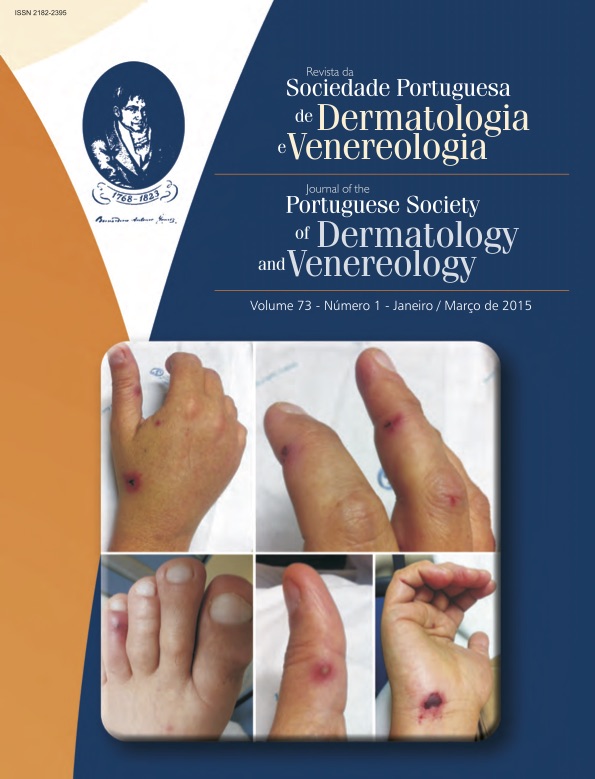FIBROXANTOMA ATÍPICO: REVISÃO CLÍNICO-PATOLÓGICA
Resumo
Introdução: O fibroxantoma atípico (FXA) é um tumor raro de histogénese indeterminada mais frequente em idosos nas áreas fotoexpostas da cabeça e pescoço. Trata-se de um tumor indiferenciado sendo o seu diagnóstico histológico de exclusão. Apesar de classicamente indolente, os casos descritos associados a metastização atribuem-lhe uma malignidade intermédia.
Material e métodos: Foi objetivo deste estudo retrospetivo rever e caracterizar os casos de FXA diagnosticados no nosso serviço entre 2008 e 2014. Foram avaliadas variáveis demográficas, clínicas, dados histológicos, imunohistoquímicos, terapêutica cirúrgica e recidiva.
Resultados: Foram diagnosticados 12 casos de FXA, 11 do sexo masculino e 1 do sexo feminino, o mais novo com 25 anos e os restantes com idade média de 76 anos. Apresentaram-se como nódulos/tumores com diâmetro médio de 1,9cm, todos localizados na cabeça. Histologicamente revelaram-se lesões bem delimitadas com grande atipia citológica e elastose solar frequente, todas classificadas na variante mista (células fusiformes e histiocitárias). Na imunohistoquímica verificou-se positividade para a vimentina e negatividade para as citoqueratinas e proteína S100 em todos os casos, sendo positivos o CD10 e CD99 na maioria dos casos. A terapêutica foi cirúrgica com excisão radical da lesão em 10 doentes, sendo a recidiva local de 10% num seguimento médio de 3 anos.
Conclusões: Os resultados obtidos foram concordantes com outras séries da literatura. Dada a clínica inespecífica e tratando-se de um tumor histologicamente indiferenciado a imunohistoquímica é essencial, não existindo ainda marcadores suficientemente específicos. Apesar do bom prognóstico na maioria dos casos a vigilância destes doentes é recomendada.
Downloads
Referências
Fretzin DF, Helwig EB. Atypical fibroxanthoma of the skin – A clinicopathologic study of 140 cases. Cancer. 1973; 31(6):1541-52.
Helwig EB. Atypical fibroxanthoma. Text J Med. 1963; 59:664-7.
Weedon D, Kerr JF. Atypical fibroxanthoma of skin: an electron microscope study. Pathology. 1975(3); 7:173-7.
Woyke S, Domagala W, Olszewski W, Korabiec M. Pseudosarcoma of the skin: an electron microscopic study and comparison with the fine structure of spindle-cell variant of squamous carcinoma. Cancer. 1974; 33(4):970-80.
Lee CS, Chou ST. P53 protein immunoreactivity in fibrohistiocytic tumors of the skin. Pathology. 1998; 30:272-5.
Dei Tos AP, Maestro R, Doglioni C, Gasparotto D, Boiocchi M, Laurino L, et al. Ultraviolet-induced p53 mutations in atypical fibroxanthoma. Am J Pathol. 1994; 145(1):11-7.
Patterson JW, Jordan WP Jr. Atypical fibroxanthoma in a patient with xeroderma pigmentosum. Arch Dermatol. 1987; 123(8):1066-70.
Dilek FH, Akpolat N, Metin A, Ugras S. Atypical fibroxanthoma of the skin and the lower lip in xeroderma pigmentosum. Br J Dermatol. 2000; 143(3):618-20.
Mirza B, Weedon D. Atypical fibroxanthoma: a clinicopathological study of 89 cases. Australas J Dermatol 2005; 46(4):235-8.
Ang GC, Roenigk RK, Otlev CC, Kim Phillips P, Weaver AL. More than 2 decades of treating atypical fibroxanthoma at mayo clinic: what have we learned from 91 patients? Dermatol Surg. 2009; 35(5):765-72.
Kargi E, Gungor E, Verdi M, Kuiaçogiu S, Erdogan B, Alli N, et al. Atypical fibroxanthoma and metastasis to the lung. Plas Reconstr Surg 2003; 111(5):1760-2.
Giuffrida TJ, Kligora CJ, Goldstein GD. Localized cutaneous metastases from an atypical fibroxanthoma. Dermatol Surg. 2004; 30(12): 1561-4.
Lum DJ, King AR. Peritoneal metastases from an atypical fibroxanthoma. Am J Surg Pathol. 2006; 30(8):1041-6.
Luzar B, Calonge E. Morphological and immunohistochemical characteristics of atypical fibroxanthoma
with a special emphasis on potential diagnostic pitfalls: a review. J Cutan Pathol. 2010; 37(3):301-9.
Iorizzo LJ, Brown MD. Atypical fibroxanthoma: a review of the literature. Dermatol Surg. 2011; 37(2): 146-57.
Hollmig ST, Rieger KE, Henderson MT, West RB, Sundram UN. Reconsidering the diagnostic and prognostic utility of LN-2 for undifferentiated pleomorphic sarcoma and atypical fibroxanthoma. Am J Dermatopathol. 2013; 35(2):176-9.
MCCalmont TH. AFX: what we now know. J Cutan Pathol. 2011; 38(11):853-6.
Gru AA, Santa Cruz DJ. Atypical fibroxanthoma: a selective review. Semin Diagn Pathol. 2013; 30(1):4-12.
Dotto J, Glusac E. Best practices in diagnostic immunohistochemistry: pleomorphic cutaneous spindle cell tumors. 2008; 132(5):732.
Gray Y, Robidoux HJ, Farrel DS, Robinson-Bostom L. Squamous cell carcinoma detected by high-molecular- weight cytokeratin immunostaining mimicking atypical fibroxanthoma. Arch Pathol Lab Med 2001; 125(6):799-802.
Sigel JE, Skacel M, Bergfeld WF, House NS, Rabkin MS, Goldblum JR. The utility of cytokeratin 5/6 in the recognition of cutaneous spindle cell squamous cell carcinoma. J Cutan Pathol. 2001; 28(10):520-4.
Sakamoto A, Oda Y, Yamamoto H, Oshiro Y, Miyajima K, Itakura E, et al. Calponin and h-caldesmon expression in atypical fibroxanthoma and superficial leiomyosarcoma. Virchows Arch. 2002;440(4):404-9.
Hafner J, Kunzi W, Weinreich T. Malignant fibrous histiocytoma and atypical fibroxanthoma in renal transplant recipients. Dermatology. 1999; 198(1):29-32.
Kanitakis J, Euvrard S, Montazeri A, Garnier JL, Faure M, Claudy A. Atypical fibroxanthoma in a renal graft recipient. J Am Acad Dermatol. 1996; 35(2):262-4.
Ferri E, Iaderosa GA, Armato E. Atypical fibroxanthoma of the external ear in a cardiac transplant recipient: case report and the causal role of the imunosuppressive therapy. Auris Nasus Latynx. 2008; 35(2):260-3.
Todos os artigos desta revista são de acesso aberto sob a licença internacional Creative Commons Attribution-NonCommercial 4.0 (CC BY-NC 4.0).








